Gopachal rock cut Jain monuments
Gopachal rock-cut Jain monuments, also called Gopachal Parvat Jaina monuments, are a group of Jain carvings dated to between 7th and 15th century. They are located around the walls of the Gwalior Fort, Madhya Pradesh. They depict Tirthankaras in seated Padmasana posture as well as standing Kayotsarga posture, in the typical naked form of Jain iconography.
| Gopachal Parvat Gopachal rock cut Jain monuments | |
|---|---|
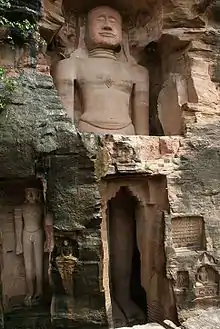 Shri Adinatha | |
| Religion | |
| Affiliation | Jainism |
| District | Gwalior |
| Deity | Tirthankaras |
| Location | |
| Location | Gwalior Fort |
| State | Madhya Pradesh |
| Country | India |
 Shown within India 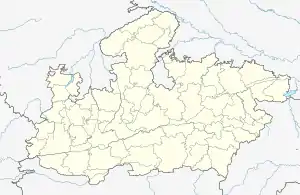 Gopachal rock cut Jain monuments (Madhya Pradesh) | |
| Geographic coordinates | 26°12′55.1″N 78°10′02.9″E |
| Architecture | |
| Style | Jainism |
| Creator | Tomaras of Gwalior |
| Date established | 7th-century |
| Completed | 15th-century |
The number of Jain rock shrines at Gwalior, with numerous monumental statues, is unmatched anywhere else. James Burgess writes: "In the 15th century, during the reign of the Tomara Rajas, the Jains seem to have been seized with an uncontrollable impulse to convert the cliff that sustains the fort into a great shrine in honour of their religion, and in a few years excavated the most extensive series of Jaina caves known to exist anywhere."[1]
Location
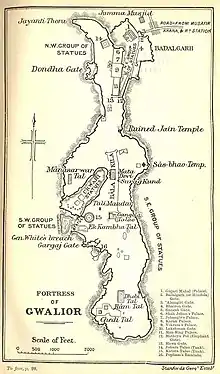
The Gopachal rock-cut Jain monuments are located on the rock cliffs of the hill topped by the Gwalior Fort, Madhya Pradesh. Gopachal is the old designation of the Gwalior Fort.
There are five clusters of monuments that surround the hill, as can be seen in the 1901 map.[2][3]
- South-East Group: Popularly referred to as Ek Patthar Ki Bawadi group, the cluster is now termed the "Gopachal Atishya Kshetra" by the local Jain community.[4] The group includes 26 caves in a row spanning about half a mile. There are 13 inscriptions from 1468-1473 AD.[5] The entrance to the site is close to the Dindayal City Mall.
- South-West Group: Now termed Trishalagiri. The group is the first one encountered when driving to the Urvai Gate, just outside the fortifications. There are the oldest Jain monuments in Gwalior from the post-Gupta period. Archaeologist L.B. Singh dates them to 6th to 8th cent AD.[6]
- Urvahi group: In both sides of the road, just before entering the hilltop fort gate. These are the most visited since they are visible from the road itself. There are six inscriptions from 1440–1453 AD.
- North-West group: Now termed Naminath Giri group after Lord Naminath. They are hard to access. There is an inscription of 1470 AD. The group appears to have escaped the destruction by Babur, and thus the monumental image of Lord Naminath is in its pristine form.
- North-East group: Now termed Naimgir group after Lord Neminath.
Alexander Cunningham noted a Jain temple converted into a mosque just north of the Sas-Bahu temples in the fort containing a Jain inscription of AD 1108. Also within the fort there is an abandoned Jain temple which is now within the Scindia School playground and thus no longer accessible. Several large Jain sculptures are placed within the Teli ka Mandir compound.
The Gwalior city and the fort is connected to other Indian cities by major highways NH 44 and 46 (Asian Highway 43 and 47), a railway station and airport (IATA: GWL). It is located near other historic Hindu and Jain temples from the medieval era.[7][8][9]
History
The Gopachal rock-cut monuments are a part of nearly 100 Jain monuments found in and around the Gwalior city, but these are dated earlier than the Siddhachal Caves located about 2 kilometres (1.2 mi) north of these monuments. Both monuments were defaced and desecrated around 1527 when the Emperor Babur ordered their destruction.[10][11][12] Centuries later, the Jain community restored many of the statues by adding back stucco heads on the top of the damaged idols.[10]
The prolific Apabhramsha author Raidhu was responsible for consecrating many of the Jain rock carved images as attested by multiple inscriptions.[13] These include the two colossal images of Shri Adinatha (57 feet) and Shri Chandraprabha.[14]
Kurbuddin Aibak captured the fort from Parihars in 1196 AD and held it until his death in 1210. Altmash captured the fort in 1232 and built the fortifications at the Urvahi gate. The Tomars acquired control in 1394 and held it until 1517.
Mughal Emperor Babar conquered Gwalior in AD 1527. Babar ordered the destruction of the Jain statues, as he mentions in his memoirs. The heads of the statues at Urvahi gate and the Ek Patthat ki Bawadi were damaged. The Urvahi gate sculptures were repaired at some later time by the local Jains. The South-West Group and North West group sculptures survived because they were in inconspicuous and hard to reach places. and The Mughals kept control until Muhammad Shah. Scindias, the Maratha clan, took control in 1731. Shortly before that, Jain temples were constructed again in Gwalior city in 1704 AD, including the Jain Golden Temple, Gwalior.[15]
Description
The Gopachal rock-cut monuments depict the Tirthankaras in seated or standing meditating positions. They are not as colossal as some of those found in the Siddhachal Caves, but they are big. The Gopachal monuments include standing and seated Shri Rishabhanatha (Adinatha), Neminatha, Parshvanatha and Shri Mahavirasvami.[10][16][7]
According to Jains, Tirthankara Parshvanath delivered his discourse (deshna) on this hill.
Gallery
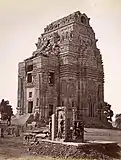 Jain statues in Teli ka Mandir compound, Lala Deen Dayal in 1882
Jain statues in Teli ka Mandir compound, Lala Deen Dayal in 1882 Shri Adinatha Bawangaja, 1895 photo, Urvahi gate group, Urvahi gate group
Shri Adinatha Bawangaja, 1895 photo, Urvahi gate group, Urvahi gate group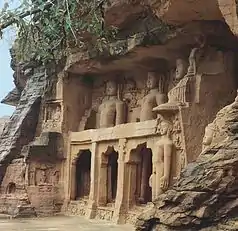 Jain statues, Urvahi gate group
Jain statues, Urvahi gate group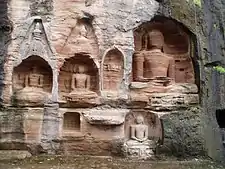 Seated in meditating position
Seated in meditating position%252C_Gwalior_Fort_India.jpg.webp) Shri Parshvanatha, Urvahi gate group
Shri Parshvanatha, Urvahi gate group.jpg.webp) Notches for wooden stairs, Urvahi gate group
Notches for wooden stairs, Urvahi gate group.jpg.webp) Jain Tirthankar statues, Ek Pathar ki Bavadi
Jain Tirthankar statues, Ek Pathar ki Bavadi.jpg.webp) Jain Tirthankar statues, Ek Pathar ki Bavadi
Jain Tirthankar statues, Ek Pathar ki Bavadi.jpg.webp) Jain Tirthankar statues, Ek Pathar ki Bavadi
Jain Tirthankar statues, Ek Pathar ki Bavadi
See also
- Jain art
- Gwalior
- Siddhachal Caves Gwalior Fort Urwahi Valley/Gate area
- Raidhu, the Gopachal Prathishacharya
References
- The Cave Temples Of India, James Burgess, 1880, p. 509
- Ramjeet Jain, Gwalior Vaibhav Gopachal, 3rd edition, 2004.
- T. V. G Sastri, The Jain sanctuaries of the fortress of Gwalior, Kunda Kunda Jñānapīṭha, 1997
- एक ही चट्टान पर जैन समाज के 24 तीर्थंकर, Bhaskar News Network, Apr 17, 2019
- Four Reports Made During the Years, 1862-63-64-65, Volume 2, Sir Alexander Cunningham, Government Central Press, 1871, p. 367
- L. B. Singh, Puratattva, May 2005
- Kurt Titze; Klaus Bruhn (1998). Jainism: A Pictorial Guide to the Religion of Non-violence. Motilal Banarsidass. pp. 106–110. ISBN 978-81-208-1534-6.
- Group of temples at Batesar, ASI Bhopal Circle (2014)
- Naresar Temples, ASI Bhopal Circle (2014)
- Gwalior Fort: Rock Sculptures, A Cunningham, Archaeological Survey of India, pages 364-370
- Kurt Titze; Klaus Bruhn (1998). Jainism: A Pictorial Guide to the Religion of Non-violence. Motilal Banarsidass. pp. 101–102. ISBN 978-81-208-1534-6., Quote: "In 1527, the Urvahi Jinas were mutilated by the Mughal emperor Babar, a fact he records in his memoirs".
- Trudy Ring; Noelle Watson; Paul Schellinger (2012). Asia and Oceania: International Dictionary of Historic Places. Routledge. p. 314. ISBN 978-1-136-63979-1.
- Phyllis Granoff 2006, p. 31.
- Phyllis Granoff 2006, p. 32.
- देश का इकलौता जैन स्वर्ण मंदिर, इसकी दीवारों में जड़ा है करोड़ों का सोना, Dainik Bhaskar, Aug 31, 2015
- Gwalior Fort, Archaeological Survey of India, Bhopal Circle, India (2014)
External links
- The Rock-cut Jain Monuments of Gwalior – Introduction, Kevin Standage, MARCH 25, 2019
- Gopachal Ek Patthar Ki Bavadi Streetview
| Wikimedia Commons has media related to Gopachal. |